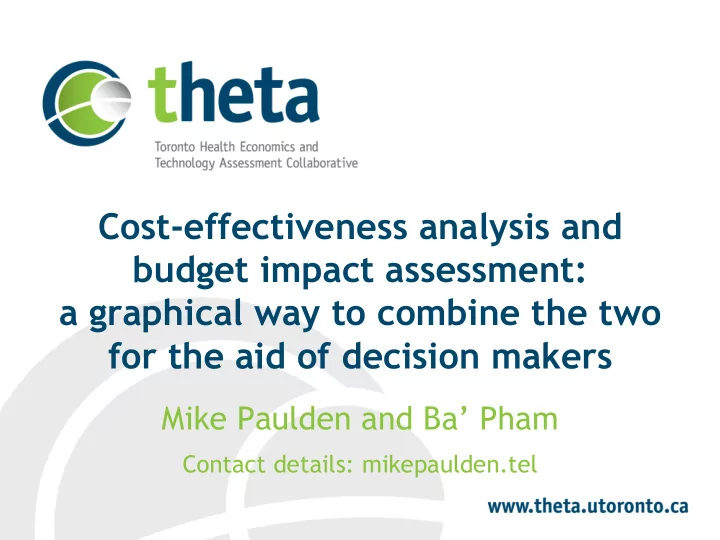

Cost-effectiveness analysis and budget impact assessment: a graphical way to combine the two for the aid of decision makers Mike Paulden and Ba’ Pham Contact details: mikepaulden.tel
Introduction Many health care decision makers consider • both cost-effectiveness analysis (CEA) and budget impact assessment (BIA) However, these are usually considered • separately and it is the job of the decision making committee to implicitly make the necessary trade-offs between the two • By combining these we make the trade-offs explicit in order to aid decision makers
Example Oncotype DX is a gene expression profiling • assay for early-stage breast cancer We conducted a CEA and BIA for the Ontario • Health Technology Advisory Committee CEA and BIA were presented separately • CEA results: ∆C=$3505 , ∆E=0.22 QALYs • ICER=$15,932 per QALY BIA estimate: N=3825 per year • Budget impact $4m per year
What actually is budget impact? Defined by a recent ISPOR task force as: • • “… the financial consequences of adoption and diffusion of a new health-care intervention within a specific health-care setting or system context given inevitable resource constraints.” But what are “financial consequences”? • • To understand the “consequences” of adoption we must consider opportunity cost Critical question: is the budget fixed? •
Fixed vs flexible health budgets If the budget is perfectly fixed , adoption • displaces other technologies, resulting in forgone health elsewhere in the system “Health” rather than financial consequence • By definition there is no budget impact • If the budget is perfectly flexible , adoption • results in a budget impact of ∆C x N If the budget is partially fixed , adoption • results in budget impact and forgone health
How much health is forgone ? When the budget is perfectly or partially • fixed , any costs falling within the budget will displace other technologies, resulting in forgone health elsewhere in the system To estimate this we need an estimate of the • shadow price of the budget , denoted by k Efforts underway in the UK to estimate k • Dividing the costs that fall within the • budget by k gives us the health forgone
Is the budget impact worth it ? When the budget is perfectly or partially • flexible , any costs resulting in an expansion of the budget will ultimately fall on other sectors and/or taxpayers We need an estimate of the amount of cost • the decision maker is willing to impose on other sectors and/or taxpayers in order to gain a QALY within the health system We denote this as m (distinct from k ) •
Example: perfectly fixed budget ∆C=$3505, ∆E=0.22 QALYs, N=3825 • If the budget is perfectly fixed , adopting • Oncotype DX has no impact on the budget There is a direct health benefit of 0.22 x • 3835 = 842 QALYs but an indirect health loss since $3505 x 3825 = $13.4m will fall on the budget and displace other health Critical question: does the direct health • benefit exceed the indirect health loss?
Net budget impact (millions) $20 $15 $10 $5 Net health benefit Net health benefit k=$20k k=$100k $0 -500 -250 0 250 500 750 1000 Net health benefit (QALYs) -$5 -$10
Example: perfectly flexible budget ∆C=$3505, ∆E=0.22 QALYs, N=3825 • If the budget is perfectly flexible , adopting • Oncotype DX results in a budget impact of $3505 x 3825 = $13.4m Again there is a direct health benefit of • 842 QALYs but no indirect health loss since no other technologies need to be displaced Critical question: is the gain of 842 QALYs • worth increasing the budget by $13.4m?
Net budget impact (millions) $20 m=$50k Net health benefit & $15 net budget impact $10 $5 Direct health benefit $0 -500 -250 0 250 500 750 1000 Net health benefit (QALYs) -$5 -$10
Example: partially fixed budget ∆C=$3505, ∆E=0.22 QALYs, N=3825 • If the budget is partially fixed , adopting • Oncotype DX results in a budget impact of somewhere between $0 and $13.4m There is a direct health gain of 842 QALYs • but an indirect health loss since the remaining costs will fall within the budget Critical question: is the net health gain • worth the increase in the budget?
Net budget impact (millions) $20 m=$100k m=$50k $15 FLEXIBLE BUDGET $10 $5 k=$20k k=$100k FIXED BUDGET $0 -500 -250 0 250 500 750 1000 Net health benefit (QALYs) -$5 -$10
Net budget impact (millions) $20 $15 $10 $5 $0 -500 -250 0 250 500 750 1000 Net health benefit (QALYs) -$5 -$10
Summary • A single graph can simultaneously display net health gain and budget impact across a range of plausible values of k and m and for all possible degrees of budget fixity • Only ∆C , ∆E and N need to be known • Interpreted in exactly the same way as the familiar cost-effectiveness (CE) plane • Can instantaneously show whether or not an adoption decision justifies its budget impact
Thank you! For a PDF copy of this presentation and a list of references please visit theta.utoronto.ca/?0129 or scan the barcode with your phone or tablet
Recommend
More recommend